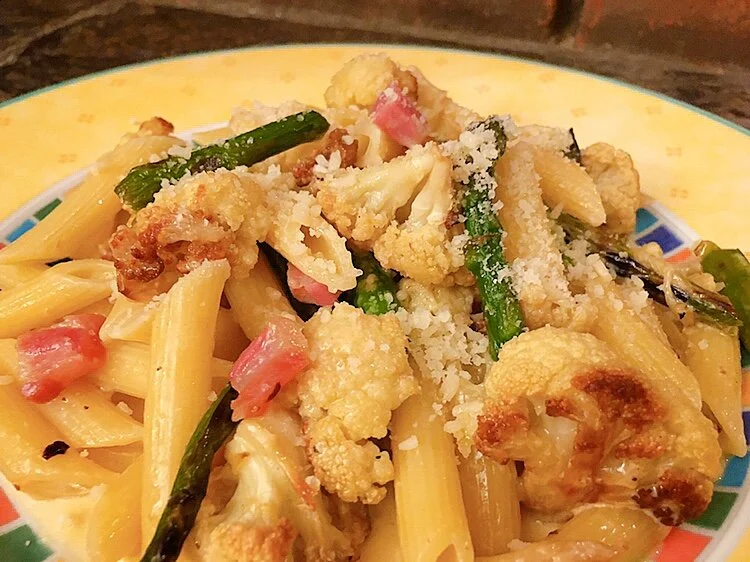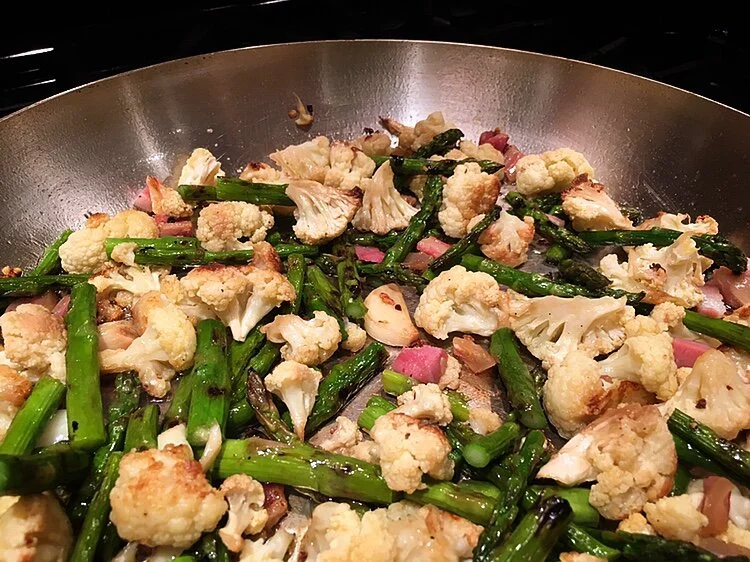Leftover Veggies = A Second Dinner (or Side Dish)
A few weeks ago, I met a former student, A.J., for a cup of coffee. I love keeping in touch with former students, hearing what they are doing now! Among other things, A.J. recently got married, and as we talked about cooking, he mentioned how he and his wife, Grace, lead very busy professional lives and often don’t have time to cook. Even when they do cook, he said, they find themselves with random leftovers and don’t know what to do with them, and he suggested I post some easy ideas for that.
Frankly, this is something I do all the time! How often does my husband, Hank, say to me, “We have nothing in the house for dinner,” and I find some random item in the fridge and build a meal around it!
This recipe was a favorite of my son, Wilson, when he was growing up. My kids love roasted cauliflower and we had that as our vegetable all the time, so the most common iteration of this dish has been with leftover roasted cauliflower, but it can be made with so many different vegetables.
At the end of a busy stretch last week, we found ourselves with leftover roasted cauliflower and grilled asparagus, and so that’s the version in the photo. But really it can be made in many variations. Different vegetables will react differently with the liquid in the pan (for example, broccoli tends not to thicken the sauce very much), but a bit of Parmesan will help if it seems too thin. Most important is that you take the pasta directly from the boiling water into the pan with the vegetables – if it’s a long pasta such as spaghetti, use tongs; if a shape, use a spider or small strainer.
Depending on the amount of vegetables and pasta, this could end up as a side dish or a main course, and please don’t reject it if you don’t eat pork or are vegetarian! Use crumbled turkey sausage instead of pancetta, or just sauté some chopped shallot or onion and omit the meat altogether! (I always have pancetta in the freezer so I can use some at a moment’s notice.)
To be more accurate, this is not so much a recipe as a technique, but here it is in a quasi-recipe format!
Leftover Veggie Pasta
2-3 Tablespoons olive oil
½ thick slice pancetta, cubed (half of the slice in the photo; find a place where they will slice it for you), or use other meat, such as crumbled turkey sausage, or no meat and replace with a small chopped onion
1-3 cups leftover vegetables (roasted, sautéed, grilled, or steamed)
2-3 garlic cloves, halved
¼ teaspoon crushed red pepper flakes, or more to taste (optional)
½ pound pasta (you can make more, but be warned it gets more difficult to mix it in the skillet the more pasta you make)
½ cup heavy cream (optional, but delicious if you have it; also heavy cream can be frozen, so I will freeze extra in small container for dishes such as this)
Olive oil, if needed
Parmesan cheese, grated
Start a large pot of salted water to boil. While waiting for it to come to a boil, begin the next step.
Heat the olive oil in a large skillet over medium heat until shimmering. Add pancetta or onions, garlic, and crushed red pepper flakes if using. Sauté until lightly brown. Add leftover vegetables and stir occasionally to heat through. (Remember, these vegetables have already been cooked!) At this point toss the pasta into the boiling water, and cook according to the package directions.
Remove the garlic pieces once brown, or before adding the pasta. (When I am making something like this, I often allow cut cloves of garlic to flavor the oil, and then discard them before serving. This comes from times when life was busier, the kids were young, and I could get distracted, and garlic cut smaller would burn more quickly and leave a bitter taste in the finished dish. Feel free to use minced garlic and leave it in if you prefer, just keep a close eye on it!) If the vegetables begin to brown too much and the pasta is not yet done, reduce the heat to low.
When the pasta is done, turn off the heat under the pasta pot, move the pot right next to the skillet, and raise the heat under the skillet to medium if it has been turned down. Take the pasta directly from the water into the skillet. The water that clings to the pasta will make it sizzle, and that’s what you want. Add the heavy cream if using. Stir everything together, and add another 2-4 Tablespoons of pasta water if it seems dry. If it seems wet, just give it a minute and the pasta will continue to absorb the liquid.
Serve with a drizzle of olive oil if it has gotten too dry (which is less likely if you use cream). Adjust with salt and pepper if needed. (It’s very difficult to give any specifics on this because it depends on the saltiness of the pancetta and how much seasoning was used in cooking the vegetables the first time.) Serve with grated Parmesan.




